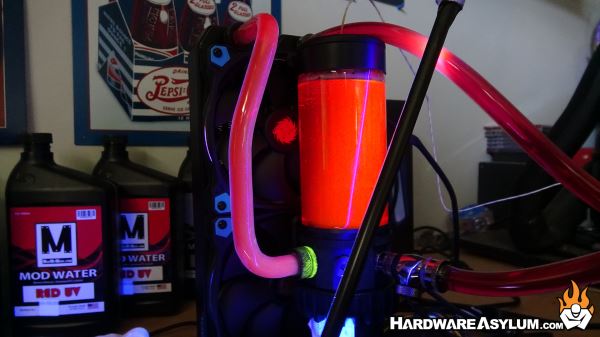Modwater PC Watercooling Coolant Performance Review
Author: Dennis GarciaIntroduction
I have been watercooling for a very long time and over the years I have seen a number of changes both in how loops are built and the performance of those loops. In 2003 I reviewed the asetek WaterChill which was a full DIY loop offered by asetek and one of the first complete watercooling kits you could buy that used high quality radiators and fully machined waterblocks. Of course before that folks cobbled loops together using automotive heater cores and blocks they soldered together in their garage.
As the hobby grew so did the quality of the components. Danger Den was a popular brand in the US and I reviewed products from few local startups including the Demonic XTC and PolarFLO TT and even picked up one of the famed White Water blocks that started it all. These were all great products built by hardware enthusiasts with innovative ideas and unique access to a machine shop.

The interesting thing is that early watercooling loops all used distilled water. Distilled water was free of impurities and wouldn’t leave hard water deposits in your loop. This fluid was also one of the driving factors behind the phrase “don’t run mixed metals in your loop" as it also promoted galvanic corrosion and growth of bugs and other nastiness.
Enthusiasts looking to get some extra protection or experiment with subzero cooling would look to exotic fluids such as automotive antifreeze and even windshield washer fluid. Both of these are alcohol based fluids designed for extreme environments and were rather toxic. The dangers associated with these fluids is what started a land rush to create a coolant that was compatible with the watercooling needs of the PC while also allowing users to experiment with different colors, different metal combinations and cooling performance.
In this review we are looking at Modwater Coolant from ModMyMods. This is an in house product that has been in development for well over two years and is available for purchase from ModMyMods.com.

The coolant they sent over is their basic clear and a Red UV. As with most modern coolants the base fluid is what provides protection for the system and the dyes and colorants are added to change the visual appeal. Some contain particles to make the fluid opaque while others might add a metal flake effect. All of these are added on top of the base fluid and is one of the factors we will be looking at.
When looking at coolants there are several factors that we determined to be important.
Stain
This is a big one. There is nothing worse than spending good money building a watercooling loop only to have the fluid you choose stain everything in the loop the same color as the fluid. For the most part this only impacts those building their loops using flexible tubing and plastics with a texture. Both of these will leach color from the coolant and cause it to stain.
We don’t want any staining, Stains are bad
Smell
As I mentioned before the early days of watercooling was the Wild West when it came to coolant choices. Distilled water was preferred however some used automotive antifreeze or window washer fluid. Both of these are toxic chemicals with distinct smells and not something you want to have leak everywhere. An ideal coolant should have little to no smell and while I'm not going to be drinking my coolant the fluid should be non-toxic
Performance
As a performance oriented website we cannot ignore performance. There are several points of contention when it comes to testing performance and some of them are correct. I believe our testing method is quite accurate and speaks to the unique aspects of what a coolant should be.
Color
Tthe final condition is color and if you are buying a pre-mixed coolant the color had better be spot on. Personally I have used pre-mixed coolant, concentrates and stand along dye kits. Provided you follow the instructions the end result should be the same.
Lets get the easy ones out of the way then we can move on to performance

